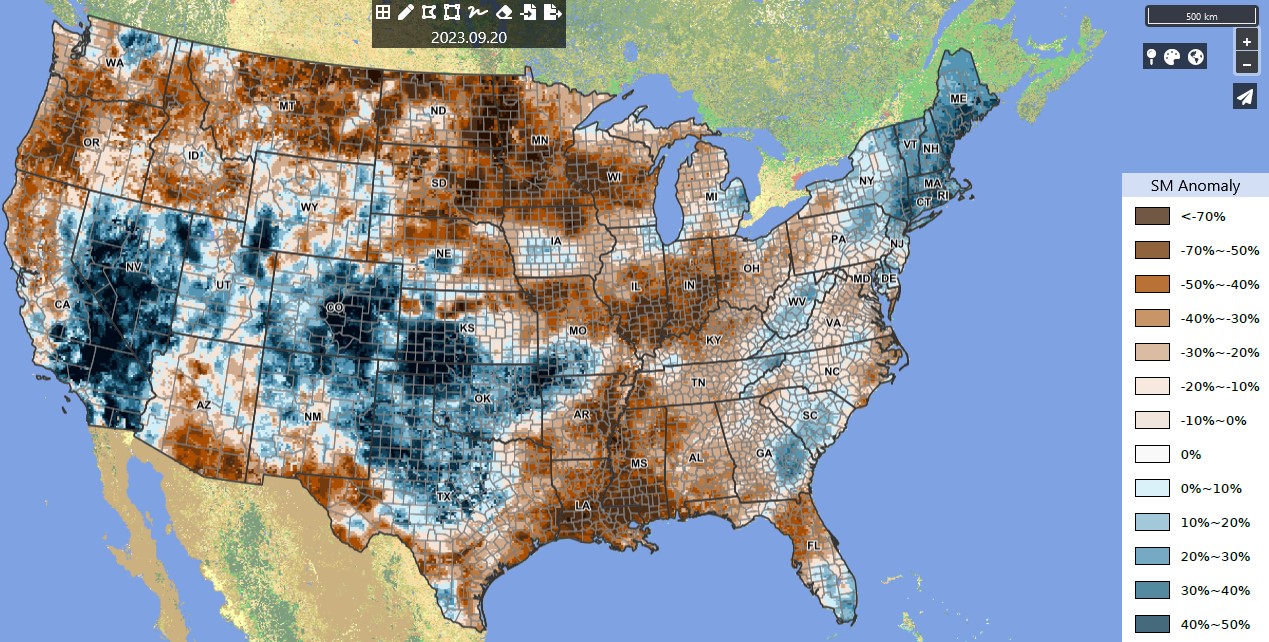
Condition Monitoring Report
Station Number: OH-HM-24
Station Name: Cheviot 3.4 W
Report Date: 9/22/2023
Submitted: 9/22/2023 8:22 PM
Scale Bar: Severely Dry
Description:
CRITICAL NEED TO WATER.
0.24 inch of rain in the past 27 days. Low humidities and warm temperatures have led to rapid drying rates and accelerated drought stress. We are now clearly into the severely dry category. Widespread browning of lawns, severe wilting of unirrigated landscape plants. Native herbaceous plants are wilting and shriveling up. Native trees showing significant drought induced early color and accelerated leaf loss. We are to a point that I am expecting increased losses of landscape plants due to drought. Soil is void of moisture. Creeks and streams are dry. Swales are dry. This is the driest I have seen it this year and we were in moderate drought earlier this summer. US Drought Monitor is lagging far behind reality.
Categories: General Awareness
Agriculture
Plants & Wildlife
Society & Public Health
Water Supply & Quality



This report is specifically for the Arbor Doctor’s location 3.4 miles west of Cheviot, OH, in the western suburbs of Cincinnati in southwest Ohio. This location is also an official cooperative observation site for the National Weather Service listed as Cheviot 3W.
What is the Condition Monitoring Report? See these links for more information:
Explanation of scale bar>>>

Midwest U.S. Drought Monitor
30 Day Precipitation:

.
Ohio 30-Day Precipitation

Snow Cover U.S. and Northern Hemisphere >>>
.
Crop Condition and Soil Moisture Analytics Map:


.
Search condition monitoring reports for the entire US>>>
Click on the title or the graphic (above) to access the
U.S. Weekly Drought MonitorPDF Version of Graphic
Click on the title or the graphic (above) to access the
U.S. Monthly Drought OutlookPDF Version of Graphic
Click on the title or the graphic (above) to access the
U.S. Seasonal Drought OutlookPDF Version of Graphic

Other Drought links:
- NWS Drought Fact Sheet
- North American Drought Monitor (NADM)
- National Integrated Drought Information System (NIDIS)
- National Drought Mitigation Center (NDMC)
- National drought summary>>>
Please remember to water…correctly!
Water once per week, one inch per week, under the entire branch spread, in the absence of rain, May through November. Either rainfall or your watering should equal the one inch per week. Do not water if the soil is already moist. Put out a sprinkler and a straight sided soup can or rain gauge and measure one inch per week. Measure the rainfall which falls in your yard. Your trees don’t care what fell at the airport!
If burlap was left on new trees, it will repel water and the tree or shrub may die. Be sure burlap and twine are removed from the top of all root balls. If your landscaper disagrees, refer him or her to the American National Standards Institute (ANSI) industry standard for installation of landscape plants.
To the extent possible recycle fallen leaves back into the soil around the trees and maintain mulch around the trees to a radius of at least 3-5 feet. Keep mulch off trunks. Use a coarse textured mulch. Avoid triple shredded mulch. Aged arborist wood chips ( https://getchipdrop.com/ ), mulched and composted leaves, pine bark, and pine straw are all good. Very finely ground mulches such as triple ground hardwood mulch are not beneficial and may inhibit moisture and oxygen exchange.
Drought: How Dry Seasons Affect Woody Plants >>>
1-inch capacity rain gauge >>>
Taylor rain gauge >>>
Watering: How and when>>>
Watering Trees and Shrubs>>>

Metal Rectangular Spot Sprinkler











 >>>
>>>





